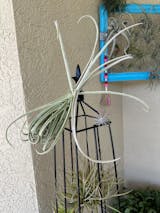Tillandsia Species
Tillandsia duratii
171
The granddaddy of fragrant Tillandsias. Native to Bolivia, Paraguay and Argentina where the trees in the arid Chaco are filled with this weird and wonderful, highly fragrant species. Having seen many thousands growing wild, I would have to call the plant a ‘vining’ species. The stem may grow to several feet long in older specimens and the leaves reach out and twist into tight curls at the tips. In nature, it may actually climb to the uppermost part of a tree in a few seasons, and many treetops are brimming with dozens of specimens reaching out into space.
The inflorescence is simple or may be branched but bears many very large purple flowers. The fragrance is very strong and a single specimen can perfume an entire garden. Does not root as an adult, so it must be attached with glue or wires to a mount. Best results may come from suspending the plant from a string or wire and hanging it in a bright airy spot. Easiest of all the fragrant Tillandsias to cultivate.






















I bought one of these years ago from Tropiflora. It can take a drought and keep on going. I love going to their nursery and looking at there beautiful plants.
Tillandsia concolor 'Cuicatlan'
159
A giant form of concolor from Mexico with the same general characteristics as the typical form, but reaching nearly a foot across. A desert dweller with a restricted range, it can be seen growing on cacti and Acacia in the extremely harsh country near Cuicatlan, Oaxaca. Stiff yellowish-green foliage tints reddish in the sun, and a shiny multiple branched spike of yellow to red with pink flowers. An outstanding plant.
Note: It is suggested by the BSI that this is a natural hybrid of unknown parentage. I doubt that. The plants are abundant in habitat but of limited range and they vary little. I believe that this is just a large and attractive clone or possibly form of the species. The ‘normal’ form does not seem to occur within the range of ‘Cuicatlan‘.






Tillandsia pseudobaileyi
285
A bulbous plant with a thick base to over an inch, and very stiff, contorted, terete wiry leaves. The plants are gray and slightly striped. The inflorescence is a tall spike with lavender branches. Very colorful in bloom. Great clumping plant, grows well just suspended from a string or wire.






Tillandsia stricta Hard Leaf
319
An all-time favorite from Brazil is about 6 inches across in a leafy rosette with stiff gray-green leaves. It produces a stunning blue-flowered, plume-shaped pink inflorescence in the summer. In nature this plant can be found growing on the restinga sands of beach dunes and in trees in the foothills of the Atlantic Range in Brazil.








Tillandsia chiapensis
154
One of the all-time favorite, easy to grow, beautiful Tillandsias, from Chiapas, Mexico. A pinkish-silver plant with wide, leathery, scurfy leaves in a broadly spreading open rosette. Can grow to 18 inches, but usually is much smaller.
The inflorescence, which can last in color for a year, is an inflated, sometimes branched, pink spike. A cliff-dweller from the dramatic canyons of Chiapas, it best kept mounted in bright light, and fed frequently.












As always . . . everything was Great !
Tillandsia espinosae Large Form
364
This is the same plant in every way as the regular form of the species, except much, much larger. Reaching up to 12 inches in diameter, with stolons of 6 to 8 inches, it is an impressive plant. The many leaves are silvery, with an 8 inch bright red spike with blue flowers. This rare form is restricted to the north central Pacific coast of Ecuador. Grow mounted, bright as with most Tillandsias. Please note that this species was described as and was considered a Vriesea until the recent DNA studies prompted a realignment to the genus Tillandsia.

Came on time and a nice healthy plant always satisfied with Tropiflora.Now to make it bloom.





